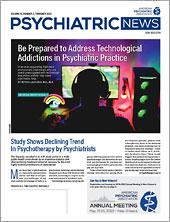StrandDx-ASD Receives Breakthrough Designation
The U.S. Food and Drug Administration granted Breakthrough Device designation to Linus Biotechnology Inc.’s StrandDx-ASD autism spectrum disorder (ASD) diagnostic aid, the company announced last December. The goal of the FDA Breakthrough Device Program is to provide patients and health care providers with timely access to medical devices by speeding up their development, assessment, and review.
StrandDx-ASD uses a single strand of hair to detect molecular biomarkers associated with ASD. According to the Breakthrough Device designation label, the test is intended to assess the likelihood of ASD in children from birth to 18 months old and aid in the diagnosis of ASD in patients aged 18 months to 21 years.
Esmethadone May Be Useful for Depression as Adjunctive Treatment
A study in the American Journal of Psychiatry suggests that REL-1017 (esmethadone) may be useful as an adjunctive treatment for patients with major depressive disorder (MDD), Relmada Therapeutics announced last December. REL-1017 is a novel N-methyl-D-aspartate (NMDA) receptor.
In a phase 2 trial, 62 patients with MDD were randomized to REL-1017 (25 mg or 50 mg) or placebo daily for seven days. The primary endpoint was an improvement in the Montgomery–Åsberg Depression Scale (MADRS) score at day 7.
MADRS scores improved on day 4 in patients who took either dose of REL-1017, compared with those who took placebo. The improvement continued through day 14, seven days after the patients stopped taking the medication. From baseline to day 7, MADRS scores decreased a mean of 16.8 points in patients who took 25 mg and 16.6 points in those who took 50 mg compared with 8.8 points in those who took placebo. There were no serious adverse events while the patients took the drug, and there were no symptoms of withdrawal after patients discontinued the drug.
“REL-1017 (Esmethadone) as Adjunctive Treatment in Patients With Major Depressive Disorder: A Phase 2a Double-Blind Randomized Trial” is posted
here.
Ansofaxine Shows Promise For Treating Depression
A phase 2 trial of LY03005 (ansofaxine hydrochloride extended release tablets) suggests that the medication may help lower symptoms of depression in patients with major depressive disorder (MDD), Luye Pharma Group announced last December.
In the trial, 260 patients with MDD were randomly assigned to receive the treatment with LY03005 at doses of 40 mg, 80 mg, 120 mg, or 160 mg or placebo for six weeks. The primary endpoint was a change in score from baseline on the 17-item Hamilton Depression Rating Scale (HAM-D17). All three doses improved symptoms compared with placebo.
At the end of six weeks, scores dropped at least 50% from baseline in 68% of patients who took 80 mg and 71% of patients who took 160 mg. All three doses of LY03005 were associated with improved symptoms of anxiety as shown by reductions in several measures, including the total HAM-A score, the HAM-A Somatic Anxiety Factor score, and the HAM-D17 Anxiety/Somatization Factor score, the HAM-A Psychic Anxiety Factor score, and the HAM-D17 Cognitive Dysfunction Factor score.
In particular, no significant adverse events were found related to sexual function or weight change, and patients did not experience a significant increase in sleepiness.
Ketamine May Be Effective For Treatment-Resistant Depression
Last December, Douglas Pharmaceuticals Ltd. announced that patients with treatment-resistant depression who took R-107 (ketamine) experienced rapid relief of their depression in a phase 2 trial.
In the trial, 231 patients with treatment-resistant depression received 120 mg of R-107 daily for five days. During that time, 73% of patients experienced rapid remission of their depression symptoms as demonstrated by a change of at least 12 points on their MADRS scores, and mean MADRS scores fell from 31 to 13.
Patients who had an improvement in their mood were then randomized to receive 30 mg, 60 mg, 120 mg, or 180 mg of R-107 or placebo twice a week for 84 days. Patients who took the 180 mg dose had a mean reduction of 6.1 points in their MADRS score at the end of the study compared with the placebo group—a difference that was statistically significant. Those who took 30 mg, 60 mg, or 120 mg of R-107 had mean MADRS score reductions of 1.9, 0.7, and 4.5 points, respectively, compared with placebo; these results were not considered statistically significant.
Pramipexole-Rasagiline Combo Improves Parkinson’s Symptoms
Patients with Parkinson’s disease may experience greater symptom improvements when taking P2B001 (a combination of extended release [ER] pramipexole 0.6 mg and rasagiline 0.75 mg) than when taking pramipexole or rasagiline alone, according to data released last December by Pharma Two B.
In the phase 3 trial, 544 patients with early Parkinson’s disease were randomized to P2B001 once daily, pramipexole ER capsule 0.6 mg once daily, rasagiline ER capsule 0.75 mg once daily, or a titrated dose of pramipexole ER capsule ranging from 1.5 mg to 4.5 mg once daily for 12 weeks.
The total Unified Parkinson Disease Rating Scale (UPDRS) score decreased 2.66 more for patients who took P2B001 than those who took pramipexole 0.6 mg. Scores decreased 3.30 points more for people who took P2B001 than those who took rasagiline 0.75 mg. Patients who took P2B001 experienced less sleepiness compared with those who took a titrated dose of extended release pramipexole.
Intranasal Zavegepant Offers Migraine Relief in Phase 3 Trial
Patients who took intranasal zavegepant in a phase 3 trial experienced greater relief of migraine pain compared with those who took placebo, Biohaven Pharmaceuticals announced last December.
In the trial, 1,269 patients who had at least a one-year history of migraine with or without aura were randomized to take a single 10 mg dose of zavegepant or placebo when they experienced a migraine attack. Twenty-four percent of patients who took zavegepant reported being free of pain two hours after taking their dose compared with 15% of patients who took placebo. In addition, 40% of patients who took zavegepant reported freedom from their most bothersome symptom at two hours compared with 31% of those who took placebo. ■
